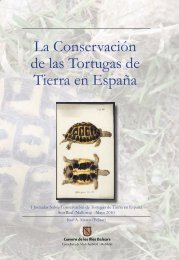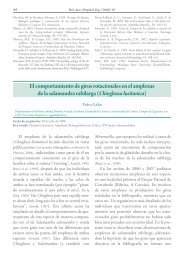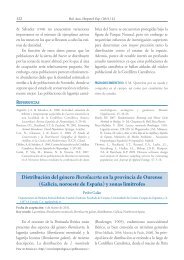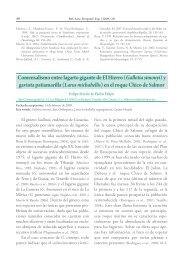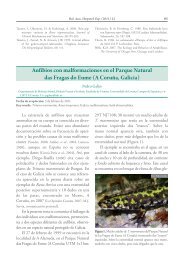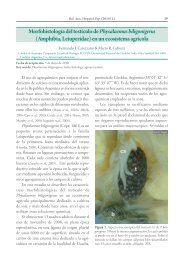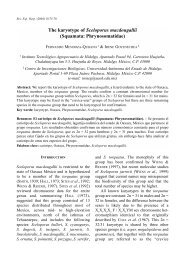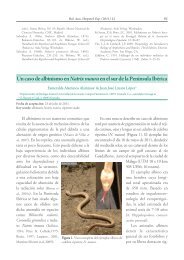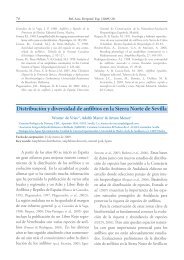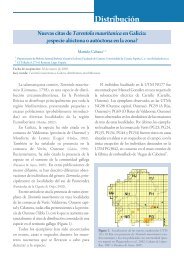Szymon Tenenbaum, a forgotten contributor to the herpetology of ...
Szymon Tenenbaum, a forgotten contributor to the herpetology of ...
Szymon Tenenbaum, a forgotten contributor to the herpetology of ...
You also want an ePaper? Increase the reach of your titles
YUMPU automatically turns print PDFs into web optimized ePapers that Google loves.
132<br />
Bol. Asoc. Herpe<strong>to</strong>l. Esp. (2010) 21<br />
<strong>Szymon</strong> <strong>Tenenbaum</strong>, a <strong>forgotten</strong> <strong>contribu<strong>to</strong>r</strong><br />
<strong>to</strong> <strong>the</strong> herpe<strong>to</strong>logy <strong>of</strong> <strong>the</strong> Balearic Islands<br />
Piotr Daszkiewicz 1 & Aaron M. Bauer 2<br />
1<br />
USM 308 - Service du Patrimoine Naturel. Muséum national d'His<strong>to</strong>ire naturelle. 57, Rue Cuvier. 75005 Paris. France.<br />
2<br />
Department <strong>of</strong> Biology. Villanova University. 800 Lancaster Avenue. Villanova. Pennsylvania 19085. USA. C.e.: aaron.bauer@villanova.edu<br />
Fecha de aceptación: 7 de febrero de 2010.<br />
Key words: <strong>Szymon</strong> <strong>Tenenbaum</strong>, his<strong>to</strong>ry, Balearic Islands, Majorca.<br />
RESUMEN: <strong>Szymon</strong> <strong>Tenenbaum</strong> (1892-1941) fue un en<strong>to</strong>mólogo polaco que publicó sobre la herpe<strong>to</strong>fauna<br />
de las Islas Baleares. Este trabajo lo hizo basándose en una visita de cuatro meses que hizo a<br />
estas islas en el año de 1913. Su mayor contribución a la herpe<strong>to</strong>logía es un trabajo sobre reptiles y<br />
anfibios de las islas Baleares, originalmente publicado en polaco en 1915 y que incluye un amplio resumen<br />
en alemán. Además de este trabajo, <strong>Tenenbaum</strong> hizo referencia a los anfibios y reptiles en su<br />
monografía sobre de la fauna de escarabajos de la Islas Baleares publicada ese mismo año. Terminó su<br />
trabajo con la ayuda del herpetólogo sueco Ot<strong>to</strong> Cyrén, y en este se reconocen 16 especies y 27 variedades<br />
de anfibios y reptiles. Además de este listado taxonómico, se documentan notas sobre his<strong>to</strong>ria<br />
natural, da<strong>to</strong>s morfológicos de algunos taxa y sugiere que los registros de Rana esculenta de las Islas<br />
Baleares corresponden en realidad a R. ridibunda (en la actualidad Pelophylax perezi). Las contribuciones<br />
de <strong>Tenenbaum</strong> a la herpe<strong>to</strong>logía de las Baleares fueron menores y aparentemente han sido poco<br />
citadas, pero su actividad es importante ya que llena un hia<strong>to</strong> temporal entre los trabajos del siglo XIX<br />
de Boscá, Braun y Bedriaga y las contribuciones posteriores de los herpetólogos españoles y alemanes<br />
del siglo XX. A la luz de las revisiones recientes sobre la his<strong>to</strong>ria de la investigación herpetógica en las<br />
Baleares, presentamos la his<strong>to</strong>ria de <strong>Szymon</strong> <strong>Tenenbaum</strong> como un ‘capítulo olvidado’.<br />
Figure 1. <strong>Tenenbaum</strong> later in life, perhaps around 1939. Pho<strong>to</strong> courtesy <strong>of</strong> <strong>the</strong> Archives <strong>of</strong> <strong>the</strong> Museum and<br />
Institute <strong>of</strong> Zoology <strong>of</strong> <strong>the</strong> Polish Academy <strong>of</strong> Sciences.<br />
Figura 1. Fo<strong>to</strong>grafía de <strong>Tenenbaum</strong> alrededor de 1939. Fo<strong>to</strong>grafía cortesía de de los Archivos del Museo e Institu<strong>to</strong><br />
de Zoología de la Academia de Ciencias de Polonia.
Bol. Asoc. Herpe<strong>to</strong>l. Esp. (2010) 21 133<br />
The his<strong>to</strong>ry <strong>of</strong> herpe<strong>to</strong>logical research in<br />
<strong>the</strong> Balearic Islands is long and rich and has<br />
included contributions from some <strong>of</strong> <strong>the</strong> greatest<br />
European herpe<strong>to</strong>logists <strong>of</strong> <strong>the</strong> last two<br />
centuries (Pérez-Mellado et al., 2008). Not surprisingly,<br />
much <strong>of</strong> this work has been carried<br />
out by Spanish herpe<strong>to</strong>logists, but scientists<br />
<strong>of</strong> o<strong>the</strong>r nationalities, for example Germans,<br />
have also made substantial advances in <strong>the</strong><br />
study <strong>of</strong> <strong>the</strong> Balearic herpe<strong>to</strong>fauna (Böhme,<br />
2004). We here wish <strong>to</strong> shed light on <strong>the</strong> contributions<br />
<strong>of</strong> a Polish biologist, <strong>Szymon</strong><br />
<strong>Tenenbaum</strong> (1892–1941), <strong>to</strong> Balearic herpe<strong>to</strong>logy.<br />
To <strong>the</strong> best <strong>of</strong> our knowledge<br />
<strong>Tenenbaum</strong>’s herpe<strong>to</strong>logical work in <strong>the</strong><br />
region has escaped <strong>the</strong> notice <strong>of</strong> all subsequent<br />
workers. It was not noted in <strong>the</strong> his<strong>to</strong>rical<br />
overview <strong>of</strong> Pérez-Mellado et al. (2008),<br />
nor is it cited in larger works on <strong>the</strong> herpe<strong>to</strong>fauna<br />
<strong>of</strong> <strong>the</strong> Balearics (e.g. Eisentraut, 1950;<br />
Mayol, 2003) or in o<strong>the</strong>r works dealing more<br />
broadly with <strong>the</strong> Spanish herpe<strong>to</strong>fauna that<br />
include <strong>the</strong> Balearics (e.g. García-París, 1985;<br />
Salvador, 1985, 1998; Barbadillo, 1987; Barbadillo et<br />
al., 1999; Salvador & García-París, 2001; Salvador &<br />
Pleguezuelos, 2002; García-París et al., 2004; Aragón-<br />
Rebollo et al., 2006). Nei<strong>the</strong>r is <strong>Tenenbaum</strong><br />
cited in <strong>the</strong> many taxon specific works on<br />
Balearic amphibians and reptiles referenced<br />
by Salvador (1998), Böhme (2004), García-<br />
París et al. (2004), and Pérez-Mellado et al.<br />
(2008). Although <strong>the</strong> work done by<br />
<strong>Tenenbaum</strong> has long since been eclipsed by<br />
that <strong>of</strong> o<strong>the</strong>rs, we take this opportunity <strong>to</strong><br />
rescue it from obscurity and give it its place<br />
in <strong>the</strong> his<strong>to</strong>ry <strong>of</strong> herpe<strong>to</strong>logical exploration <strong>of</strong><br />
<strong>the</strong> Balearic Islands.<br />
<strong>Szymon</strong> <strong>Tenenbaum</strong> (Figure 1) was born<br />
in Warsaw in 1892, where he attended <strong>the</strong><br />
prestigious Kreczmar High School. In 1911<br />
he began his studies <strong>of</strong> natural sciences at <strong>the</strong><br />
Jagiellonian University in Krakow, working<br />
in <strong>the</strong> labora<strong>to</strong>ry <strong>of</strong> Henryk Hoyer<br />
(1864–1947), an eminent specialist in <strong>the</strong><br />
field <strong>of</strong> ana<strong>to</strong>my and embryology. From 1914<br />
<strong>Tenenbaum</strong> worked as a teacher, and later<br />
direc<strong>to</strong>r, <strong>of</strong> <strong>the</strong> Jewish College in Warsaw. In<br />
1932 he received <strong>the</strong> Ph.D. at <strong>the</strong> University<br />
<strong>of</strong> Vilnius (currently Lithuania, but prior <strong>to</strong><br />
1939 part <strong>of</strong> Poland) under Jan Prüffer<br />
(1890–1958), one <strong>of</strong> <strong>the</strong> most active en<strong>to</strong>mologists<br />
<strong>of</strong> <strong>the</strong> period.<br />
<strong>Tenenbaum</strong> quickly became one <strong>of</strong> most<br />
important en<strong>to</strong>mologists <strong>of</strong> pre-war Poland,<br />
mainly specializing in beetles (see Prüffer &<br />
Wolski, 1964 for <strong>Tenenbaum</strong>’s bibliography). He<br />
published about 30 works on <strong>the</strong> fauna <strong>of</strong><br />
Poland and described several new species. He<br />
was also an expert on exotic insects and organized<br />
and participated in various scientific<br />
expeditions including ones <strong>to</strong> Brazil (1923),<br />
Mexico (1926 with T. Wolski), and Palestine<br />
(1927). He was a collabora<strong>to</strong>r and correspondent<br />
<strong>of</strong> <strong>the</strong> Commission Physiographique <strong>of</strong><br />
<strong>the</strong> Polish Academy <strong>of</strong> Sciences and Letters<br />
[Komisja Fizjograficzna PAU], <strong>the</strong> Warsaw<br />
Scientific Society, and <strong>the</strong> Polish National<br />
Museum <strong>of</strong> Zoology. <strong>Tenenbaum</strong> was also a<br />
pioneer <strong>of</strong> research on <strong>the</strong> urban fauna <strong>of</strong><br />
Europe. He co-authored Zoological Guide<br />
Through <strong>the</strong> Surroundings <strong>of</strong> Warsaw (Sumiński<br />
& <strong>Tenenbaum</strong>, 1921) a book all <strong>the</strong> more important<br />
<strong>to</strong>day because it describes many habitats<br />
that no longer exist. Although <strong>the</strong> vast majority<br />
<strong>of</strong> <strong>Tenenbaum</strong>’s research focused on beetles<br />
and various en<strong>to</strong>mological issues, he also<br />
became interested in herpe<strong>to</strong>logy and was <strong>the</strong><br />
author <strong>of</strong> three publications in this field<br />
(<strong>Tenenbaum</strong>, 1913, 1914, 1915a).<br />
After <strong>the</strong> invasion <strong>of</strong> Poland in 1939,<br />
<strong>Tenenbaum</strong> was trapped in <strong>the</strong> Warsaw Ghet<strong>to</strong>.<br />
Hungry and sick, he refused an opportunity <strong>to</strong>
134<br />
Bol. Asoc. Herpe<strong>to</strong>l. Esp. (2010) 21<br />
escape organized by Jan Żabiński (1897–1974)<br />
one <strong>of</strong> his zoologist friends and an <strong>of</strong>ficer <strong>of</strong> <strong>the</strong><br />
Polish resistance. <strong>Szymon</strong> <strong>Tenenbaum</strong> died on<br />
29 November 1941. According <strong>to</strong> Prüffer and<br />
Wolski (1964) “a serious illness was <strong>the</strong> direct<br />
cause <strong>of</strong> his death, but he could have been fully<br />
healed. It was war and Nazi barbarism that prevented<br />
him from receiving <strong>the</strong> necessary care.<br />
<strong>Tenenbaum</strong> was a direct victim <strong>of</strong> <strong>the</strong> war, he<br />
did not want <strong>to</strong> capitulate <strong>to</strong> <strong>the</strong> enemy.” This<br />
last period <strong>of</strong> Tenebaum’s life, as well as <strong>the</strong> s<strong>to</strong>ry<br />
<strong>of</strong> <strong>the</strong> survivial <strong>of</strong> his en<strong>to</strong>mological collections,<br />
hidden by Żabiński, has been chronicled in<br />
some detail (Żabińska, 1968). After <strong>the</strong> war <strong>the</strong><br />
collections, as well as <strong>Tenenbaum</strong>’s library, likewise<br />
hidden by a family friend, were <strong>of</strong>fered <strong>to</strong><br />
Figure 2. Cover page <strong>of</strong> <strong>Tenenbaum</strong>’s main contribution<br />
<strong>to</strong> herpe<strong>to</strong>logy, Reptiles and amphibians <strong>of</strong> <strong>the</strong><br />
Balearic Islands, published in 1915.<br />
Figura 2. Cubierta de la contribución herpe<strong>to</strong>lógica<br />
más importante de <strong>Tenenbaum</strong> Los Reptiles y Anfibios<br />
de las Islas Baleares publicada en 1915.<br />
<strong>the</strong> Zoological Museum in Warsaw by Mrs.<br />
Eleonora <strong>Tenenbaum</strong>-Krajewska, in accordance<br />
with her husband’s will.<br />
In 1913, <strong>Tenenbaum</strong> spent four months<br />
(April <strong>to</strong> July) in <strong>the</strong> Balearic Islands where<br />
he was based in Palma de Majorca but also<br />
visited Ibiza, Cabrera, and several smaller<br />
islets. The purpose <strong>of</strong> <strong>the</strong> trip was <strong>the</strong>rapeutic;<br />
<strong>the</strong> Mediterranean climate had been<br />
recommended by his doc<strong>to</strong>rs as beneficial for<br />
lung problems. However, ra<strong>the</strong>r than resting<br />
he used <strong>the</strong> opportunity <strong>to</strong> work on <strong>the</strong> fauna<br />
<strong>of</strong> <strong>the</strong> islands. In 1915 he published Beetle<br />
Fauna <strong>of</strong> Balearic Islands (<strong>Tenenbaum</strong>, 1915b)<br />
with an inven<strong>to</strong>ry <strong>of</strong> 1677 species (352 new<br />
for <strong>the</strong> region). Despite <strong>the</strong> title <strong>of</strong> this work,<br />
he also mentioned homopterans, molluscs,<br />
arachnids, myriapods, amphibians, and reptiles<br />
and even briefly reviewed <strong>the</strong> herpe<strong>to</strong>logical<br />
research <strong>of</strong> earlier naturalists, citing <strong>the</strong><br />
works <strong>of</strong> Martínez y Sáez (1875), Barceló i<br />
Combis (1876), Böttger (1880), Boscá (1877,<br />
1880, 1881, 1883), and Rodríguez Femenias<br />
(1887). <strong>Tenenbaum</strong> also cited his own publication<br />
on <strong>the</strong> Balearic herpe<strong>to</strong>fauna<br />
(<strong>Tenenbaum</strong> 1915a), proving that this work predated<br />
his beetle book.<br />
<strong>Tenenbaum</strong>’s main contribution on herpe<strong>to</strong>logy,<br />
Reptiles and amphibians <strong>of</strong> <strong>the</strong> Balearic<br />
Islands (Figure 2), was published in 1915 in<br />
Warsaw as a small <strong>of</strong>fprint <strong>of</strong> <strong>the</strong> Labora<strong>to</strong>ry <strong>of</strong><br />
Biology <strong>of</strong> Society <strong>of</strong> Friends <strong>of</strong> Nature<br />
[Pracownia Biologiczna Towarzystwa<br />
Miłośników Przyody]. Probably because <strong>of</strong> language<br />
(Polish, but with a relatively lengthy<br />
German summary), <strong>the</strong> date (Warsaw during<br />
<strong>the</strong> second year <strong>of</strong> <strong>the</strong> First World War), and its<br />
scarcity, <strong>the</strong> publication is practically unknown.<br />
We consulted a copy <strong>of</strong> this publication in <strong>the</strong><br />
library <strong>of</strong> <strong>the</strong> Institute <strong>of</strong> Zoology in Warsaw.<br />
This <strong>of</strong>fprint had a handwritten dedication by
Bol. Asoc. Herpe<strong>to</strong>l. Esp. (2010) 21 135<br />
<strong>Szymon</strong> Tennenbaum <strong>to</strong> “Dear Janusz” (probably<br />
Janusz Domaniewski [1891–1954], a<br />
Polish ornithologist).<br />
<strong>Tenenbaum</strong> (1915a) acknowledged that he<br />
was assisted in <strong>the</strong> determination <strong>of</strong> his<br />
Balearic herpe<strong>to</strong>logical collections by Carl<br />
August Ot<strong>to</strong> Cyrén (1878–1946), a Swedish<br />
chemical engineer and amateur herpe<strong>to</strong>logist<br />
affiliated with both <strong>the</strong> Riksmuseum in<br />
S<strong>to</strong>ckholm and <strong>the</strong> Natural His<strong>to</strong>ry Museum<br />
in Göteborg. Cyrén later published extensively<br />
on Mediterranean lacertids, but by 1915<br />
he had published only several papers <strong>of</strong> local<br />
interest in Swedish in <strong>the</strong> journal Fauna och<br />
Flora and three papers in German (Cyrén 1909,<br />
1911; Lantz & Cyrén 1913), with which<br />
<strong>Tenenbaum</strong> may have been familiar. During<br />
<strong>the</strong> period 1906–1914 Cyrén worked at <strong>the</strong><br />
Warsaw branch <strong>of</strong> Kalle Anilinfarbenfabrik<br />
(Notini 1991; Adler 2007), where he probably<br />
came in<strong>to</strong> contact with <strong>Tenenbaum</strong> through<br />
local natural his<strong>to</strong>ry connections.<br />
In <strong>the</strong> introduction <strong>to</strong> his paper<br />
<strong>Tenenbaum</strong> (1915a) wrote: “Before moving <strong>to</strong><br />
<strong>the</strong> description <strong>of</strong> forms I want <strong>to</strong> emphasize<br />
an interesting and clearly evident fact. The<br />
quantitative composition <strong>of</strong> <strong>the</strong> herpe<strong>to</strong>fauna<br />
is inversely proportional <strong>to</strong> <strong>the</strong> surface <strong>of</strong> <strong>the</strong><br />
island. Majorca, <strong>the</strong> largest <strong>of</strong> <strong>the</strong> Balearic<br />
Islands, has a rich herpe<strong>to</strong>fauna from <strong>the</strong> specific<br />
point <strong>of</strong> view, richer than o<strong>the</strong>r islands.<br />
But from <strong>the</strong> quantitative point <strong>of</strong> view, it is<br />
relatively poor. The lizards, common on<br />
small islands, are rarities on Majorca.<br />
Throughout my stay on this island, despite<br />
my research, I have failed <strong>to</strong> find a single<br />
representative <strong>of</strong> Lacerta. While on small<br />
islands, sometimes distant from Majorca by<br />
just a few dozen metres, <strong>the</strong>re were many.<br />
The amphibians and snakes, usually living in<br />
damp places, live only on <strong>the</strong> larger islands<br />
with freshwater basins. It is interesting <strong>to</strong><br />
note that <strong>the</strong> lizards live on islands not only<br />
lacking fresh water basins but with almost no<br />
vegetation. On some islands where I could<br />
not find a single insect, I quite <strong>of</strong>ten encountered<br />
lizards. The fauna <strong>of</strong> reptiles and<br />
amphibians <strong>of</strong> Balearic Islands consists <strong>of</strong> 27<br />
forms representing 16 species.”<br />
In <strong>the</strong> text only species marked by an asterisk<br />
were actually found by <strong>Tenenbaum</strong>, whereas<br />
data for all o<strong>the</strong>r taxa originated from<br />
literature sources, chiefly those <strong>of</strong> Braun<br />
(1877), Lataste (1879), Bedriaga (1879, 1880),<br />
Boscá (1880, 1883), and Rodriguez (1887). The<br />
Polish text occupies pages 3–12 <strong>of</strong> <strong>the</strong> publication,<br />
with a German summary on pages<br />
13–16. This summary, however, only deals<br />
with a few <strong>of</strong> <strong>the</strong> more interesting taxa:<br />
Lacerta Lilfordi (varieties f and h),<br />
Tropidonotus viperinus var. chersoides,<br />
Macropro<strong>to</strong>don cucullatus, and Rana ridibunda.<br />
Below we provide partial translations <strong>of</strong><br />
<strong>Tenenbaum</strong>’s accounts <strong>of</strong> <strong>the</strong> species he himself<br />
observed or collected. Ana<strong>to</strong>mical descriptions<br />
and additional information based<br />
on previous authors have been omitted.<br />
Current names <strong>of</strong> species follow Carretero et<br />
al. (2009) and are indicated in square brackets<br />
[ ]; our additional comments follow<br />
<strong>Tenenbaum</strong>’s, also in square brackets.<br />
Bufo viridis var. balearica Boettg. [Bufo balearicus]: This<br />
species is known from all islands. I found a specimen under<br />
rocks in <strong>the</strong> dry stream in San Sardina on Majorca.<br />
Rana ridibunda Pall. [Pelophylax perezi (López-<br />
Seoane)]: Before now this species has not been mentioned<br />
in <strong>the</strong> Balearic Islands. I have collected a significant<br />
number in ditches along <strong>the</strong> road around <strong>the</strong> city Ibiza<br />
on <strong>the</strong> island <strong>of</strong> <strong>the</strong> same name and in ditches along <strong>the</strong><br />
road between La Puebla and Albufera on Majorca. The<br />
specimens that I found correspond <strong>to</strong> R. ridibunda, and
136<br />
Bol. Asoc. Herpe<strong>to</strong>l. Esp. (2010) 21<br />
not Rana esculenta. In this case R. esculenta would not be<br />
part <strong>of</strong> <strong>the</strong> fauna <strong>of</strong> <strong>the</strong> Balearic Islands. [<strong>Tenenbaum</strong><br />
was correct that earlier records <strong>of</strong> R. esculenta from <strong>the</strong><br />
Balearics were incorrect, but his identification a R. ridibunda<br />
was also wrong. P. perezi is an introduced species<br />
in <strong>the</strong> Balearics (García-París, 1997).]<br />
Lacerta Lilfordi var. h. (Zoo<strong>to</strong>ca Lilfordi Günt.)<br />
[Podarcis lilfordi]: I found this beautiful variety in a lot on<br />
Cabrera in <strong>the</strong> vicinity <strong>of</strong> <strong>the</strong> port but it is also in many<br />
o<strong>the</strong>r parts <strong>of</strong> <strong>the</strong> island. Two ♂♂ from La Guardia.<br />
Lacerta Lilfordi var. f. (Lacerta muralis var. pityusensis<br />
Bosca.) [Podarcis pityusesis]: It is very common everywhere<br />
on Ibiza. It occurs mostly on s<strong>to</strong>ne fences delimiting<br />
<strong>the</strong> fields. There are many in <strong>the</strong> same city on <strong>the</strong><br />
ancient walls surrounding <strong>the</strong> castle and <strong>the</strong> ca<strong>the</strong>dral.<br />
Taren<strong>to</strong>la mauritanica L.: Very common on Majorca,<br />
Minorca, Ibiza and Cabrera. I collected <strong>the</strong> largest quantity<br />
below s<strong>to</strong>nes at Por<strong>to</strong> Pi near Palma. I have encountered<br />
it very <strong>of</strong>ten in apartments. On Cabrera I have<br />
collected a few almost black specimens. The largest specimen<br />
measured 115 mm with a regenerated tail.<br />
Hemidactylus turcicus L.: Lives in <strong>the</strong> same conditions<br />
as <strong>the</strong> previous species [Taren<strong>to</strong>la mauritaniaca]<br />
but it is much rarer. Throughout my stay I saw a few<br />
specimens, all around Palma in Majorca (Por<strong>to</strong> Pi). It is<br />
also found on Ibiza and Minorca.<br />
Macropro<strong>to</strong>don cucullatus Ge<strong>of</strong>fr.: [Macropro<strong>to</strong>don<br />
mauritanicus] I found two specimens below s<strong>to</strong>nes at Sollar<br />
in Majorca in a wetland on <strong>the</strong> edge <strong>of</strong> a creek ... <strong>the</strong> smallest<br />
specimen measuring 315 mm and <strong>the</strong> larger 475 mm.<br />
Tropidonotus viperinus Latr. var. chersoides Wagl.<br />
(var. d Schreiber) [Natrix maura]: Encountered in<br />
Majorca and Menorca. It occurs near major expanses<br />
<strong>of</strong> water. Thus it is rarely encountered in <strong>the</strong> interior<br />
<strong>of</strong> <strong>the</strong> islands. It lives in great numbers in Majorca in<br />
Albufera near Alkudja, near <strong>the</strong> edge <strong>of</strong> a large salt<br />
marsh. On sunny days, <strong>the</strong>y warm in <strong>the</strong> sun at <strong>the</strong><br />
water's edge and in <strong>the</strong> space <strong>of</strong> a few hours we could<br />
collect more than a dozen specimens effortlessly. I<br />
brought back only three specimens from Albufera<br />
and Por<strong>to</strong> Pi.<br />
Thallasochelys caretta L. [Caretta caretta]: It is found<br />
on all islands. I saw a specimen on Ibiza.<br />
Chelone mydas L. [Chelonia mydas]: I found <strong>the</strong><br />
shell <strong>of</strong> this species in <strong>the</strong> Bay <strong>of</strong> Cabrera. It is also<br />
observed in Ibiza.<br />
In addition <strong>to</strong> <strong>the</strong>se taxa <strong>Tenenbaum</strong> (1915a)<br />
listed <strong>the</strong> following taxa as components <strong>of</strong> <strong>the</strong><br />
Balearic fauna: Alytes obstetricans Boscai [Alytes<br />
muletensis], Hyla arborea var. meridionales [Hyla<br />
meridionalis], Lacerta Lilfordi typica, Lacerta<br />
Lilfordi var. a, Lacerta Lilfordi var. b, Lacerta<br />
Lilfordi var. c, Lacerta Lilfordi var. d, Lacerta<br />
Lilfordi var. e, Lacerta Lilfordi var. g [Podarcis lilfordi],<br />
Coluber scalaris [Rhinechis scalaris],<br />
Coluber leopardinus var. c [Zamenis situla, sic],<br />
Dermochelys coriace [Dermochelys coriacea],<br />
Testudo graeca, and Emys orbicularis.<br />
Unfortunately, <strong>Tenenbaum</strong>’s writings on <strong>the</strong><br />
Balearic herpe<strong>to</strong>fauna added little <strong>to</strong> <strong>the</strong> data<br />
that had already been collected and summarized<br />
by late 19th century researchers. His period <strong>of</strong><br />
activity in <strong>the</strong> Balearics came at <strong>the</strong> end <strong>of</strong> a<br />
quarter century <strong>of</strong> relative inactivity in herpe<strong>to</strong>logical<br />
investigation in <strong>the</strong> region, but his collections<br />
and observations were made over a short<br />
period <strong>of</strong> time and were combined <strong>to</strong> just a few,<br />
well-known and <strong>of</strong>ten-visited islands. Although<br />
<strong>Tenenbaum</strong> made no lasting impact on <strong>the</strong> herpe<strong>to</strong>logy<br />
<strong>of</strong> <strong>the</strong> Balearics, <strong>the</strong> “rediscovery” <strong>of</strong><br />
this Polish researcher reveals that <strong>the</strong> his<strong>to</strong>rical<br />
scope <strong>of</strong> international interest in <strong>the</strong> region was<br />
even greater than has been appreciated (Pérez-<br />
Mellado et al. 2008).<br />
ACKNOWLEDGEMENTS: We thank <strong>the</strong> Archiwum<br />
MiIZ PAN (Archives <strong>of</strong> Museum and Institute<br />
<strong>of</strong> Zoology <strong>of</strong> Polish Academy <strong>of</strong> Sciences) and<br />
Miss M. Glowka for <strong>the</strong> pho<strong>to</strong> <strong>of</strong> <strong>Tenenbaum</strong><br />
and R. Wahlgren for providing a herpe<strong>to</strong>logical<br />
bibliography <strong>of</strong> Ot<strong>to</strong> Cyrén.
Bol. Asoc. Herpe<strong>to</strong>l. Esp. (2010) 21 137<br />
REFERENCES<br />
Adler, K.K. 2007. Herpe<strong>to</strong>logists <strong>of</strong> <strong>the</strong> past, Part 2. 7-273. In:<br />
Adler, K.K. (eds.), Contributions <strong>to</strong> <strong>the</strong> his<strong>to</strong>ry <strong>of</strong> herpe<strong>to</strong>logy,<br />
Volume 2. Society for <strong>the</strong> Study <strong>of</strong> Amphibians and<br />
Reptiles (Contributions <strong>to</strong> Herpe<strong>to</strong>logy 21). Saint Louis.<br />
Aragón-Rebollo, A., Pierna Chamorro, J., Aragón-Rebollo, D. &<br />
Hernández Estévez, J.A. 2006. Anfibios y reptiles de la<br />
Península Ibérica e Islas Baleares. Ediciones Jaguar. Madrid.<br />
Barbadillo, L. J. 1987. La guia de INCAFO de los anfibios y reptiles<br />
de la Península Ibérica, Islas Baleares y Canarias. Incafo. Madrid.<br />
Barbadillo, L.J., Lacomba, J.I., Pérez-Mellado, V., Sancho, V. &<br />
López-Jurado, L.F. 1999. Anfibios y reptiles de la Península<br />
Ibérica, Baleares y Canarias. Edi<strong>to</strong>rial Planeta. Barcelona.<br />
Barceló i Combis, F. 1876. Nuevos apuntes para la fauna Balear.<br />
Catálogo de los reptiles y de los moluscos terrestres y de agua<br />
dulce observados en las islas Baleares. Pedro José Gelabert.<br />
Palma de Mallorca.<br />
Bedriaga, J. von 1879. Mémoire sur les varietés européennes<br />
du lézard des murailles. Bulletin de la Société Zoologique de<br />
France, 4: 194-228.<br />
Bedriaga, J. von 1880. Herpe<strong>to</strong>logische Studien (Fortsetzung).<br />
Archiv für Naturgeschichte, 45: 243-339, pls. XVII-XVIII.<br />
Böhme, W. 2004. The German contributions <strong>to</strong><br />
Mediterranean herpe<strong>to</strong>logy with special referente <strong>to</strong> <strong>the</strong><br />
Balearic Islands and <strong>the</strong>ir lacertid lizards. 63-82. In: Pérez-<br />
Mellado, V., Riera, N. & Perera, A. (eds.), The biology <strong>of</strong><br />
lacertid lizards. Evolutionary and ecological perspectives.<br />
Institut Menorquí d’Estudis (Recerca 8). Menorca.<br />
Böttger, O. 1880. Neu Krötenvarietät von den Balearen.<br />
Zoologische Anzeiger, 3: 642-643.<br />
Boscà, E. 1877. Catàlogo de los reptiles y amfibios observados<br />
en Espańa, Portugal, e Islas Baleares. Anales de la Sociedad<br />
Española de His<strong>to</strong>ria Natural, 6: 39-68.<br />
Boscà, E. 1880. Catalogue des reptiles et amphibiens de la<br />
Peninsule Ibérique et des iles Baléares. Bulletin de la<br />
Société Zoologique de France, 5: 240-287.<br />
Boscà, E. 1881. Correcciones y adiciones al catàlogo de los reptiles<br />
y amfibios de Espańa, Portugal é Islas Baleares. Anales de la<br />
Sociedad Española de His<strong>to</strong>ria Natural, 10: 89-112, pl.II.<br />
Boscà, E. 1883. Exploracion herpe<strong>to</strong>lógica en la isla de Íbiza. Anales<br />
de la Sociedad Española de His<strong>to</strong>ria Natural, 12: 241-250.<br />
Braun, M. 1877. Lacerta lilfordi und Lacerta muralis. Zugleich<br />
ein Beitrag zur Reptilienfauna der kleinen Inseln der<br />
Mittelmeeres. Arbeiten aus dem Zoologisch-Zoo<strong>to</strong>mischen<br />
Institut in Würzburg, N.F. 4: 1-64.<br />
Carretero, M.A., Ayllón, E. & Llorente, G. (eds.). 2009. Lista<br />
patrón de los anfibios y reptiles de España (actualizada a enero de<br />
2009). Asociación Herpe<strong>to</strong>lógica Española. Barcelona.<br />
Cyrén, O. 1909. Herpe<strong>to</strong>logische von einer Balkanreise.<br />
Zoologischer Beobachter, Der Zoologische Garten, 50: 265-<br />
271, 295-300.<br />
Cyrén, O. 1911. Beiträge zur Kenntnis des kaukasischen<br />
Feuersalamanders, Salamandra caucasia (Waga), seiner<br />
Lebensweise und Fortpflanzung. Bericht der<br />
Senckenbergischen Naturforschenden Gesellschaft in<br />
Frankfurt am Main, 42: 175-189, pl. 1.<br />
Eisentraut, M. 1950. Die Eidechsen der Spanischen Mittelmeer<br />
Inseln. Akademie-Verlag. Berlin.<br />
García-París, M. 1985. Los anfibios de España. Ministerio de<br />
Agricultura, Pesca y Alimentacíon. Madrid.<br />
García-París, M. 1997. Rana perezi Seoane, 1885. 152-153 In:<br />
Gasc, J. P., Cabela, A., Crnobrnja-Isailovic, J., Dolmen, D.,<br />
Grossenbacher, K., Haffner, P., Lescure, P., Martens, H.,<br />
Martínez-Rica, J.P., Maurin, H., Oliveira, M.E., S<strong>of</strong>ianidou,<br />
T.S., Veith, M. y Zuiderwijk, A. (eds.), Atlas <strong>of</strong> amphibians<br />
and reptiles in Europe. Societas Europaea Herpe<strong>to</strong>logica et<br />
Muséum National d’His<strong>to</strong>ire Naturelle. Paris.<br />
García-París, M., Mon<strong>to</strong>ri, A. & Herrero, P. 2004. Amphibia,<br />
Lissamphibia. In: Fauna Iberica. Vol. 24. Museo Nacional<br />
de Ciencias Naturales y Consejo Superior de<br />
Investigaciones Científicas. Madrid.<br />
Lantz, L.A. & Cyrén, O. 1913. Über die Identität von Rana macrocnemis<br />
und Rana camerani. Zoologischer Anzeiger 43: 214-220.<br />
Lataste, F. 1879. Étude sur le discoglosse. Actes de la Société<br />
Linnénne de Bordeaux, 33: 275-341, pls. III-V.<br />
Martínez y Sáez, F. 1875. Nota sobre algunos reptiles de<br />
Menorca. Anales de la Sociedad Española de His<strong>to</strong>ria<br />
Natural Actas, 4: 93-94.<br />
Mayol, J. 2003. Rèptils i amfibis de les Balears, edició revisada.<br />
Edi<strong>to</strong>rial Moll. Mallorca.<br />
Notini, G. 1991. Carl August Ot<strong>to</strong> Cyrén. 155-156. In:<br />
Svenska män och kvinnor — Biografisk uppslagsbok. Albert<br />
Bonniers förlag. S<strong>to</strong>ckholm.<br />
Pérez-Mellado, V., Corti, C. & Vidal, J.M. 2008.<br />
Herpe<strong>to</strong>logical explorations <strong>of</strong> <strong>the</strong> Balearic Islands during<br />
<strong>the</strong> last two centuries. Proceedings <strong>of</strong> <strong>the</strong> California<br />
Academy <strong>of</strong> Sciences, 4th ser., 59, Suppl. 1: 85-109.<br />
Prüffer, J. & Wolski, T. 1964. Działalość naukowa dok<strong>to</strong>ra<br />
<strong>Szymon</strong>a <strong>Tenenbaum</strong>a [On <strong>the</strong> scientific activity <strong>of</strong> Dr.<br />
<strong>Szymon</strong> <strong>Tenenbaum</strong>]. Przegląd Zoologiczny 1/1964: 5-9.<br />
Rodríguez Femenias, J.J. 1887. His<strong>to</strong>ria Natural de las Baleares.<br />
Zoolojía. Adiciones á la fauna balear. Imprenta Fábregas. Mahón.<br />
Salvador, A. 1985. Guia de campo de los anfibios y reptiles de la<br />
Peninsula Iberica, Islas Baleares y Canarias. Alfredo<br />
Salvador Milla. León.<br />
Salvador, A. (coord.). 1998. Reptiles. In: Fauna Iberica. Vol.<br />
10. . Museo Nacional de Ciencias Naturales y Consejo<br />
Superior de Investigaciones Científicas. Madrid.<br />
Salvador, A. & Pleguezuelos, J.M. 2002. Reptiles españoles,<br />
identificación, his<strong>to</strong>ria natural y distribución. Canseco<br />
Edi<strong>to</strong>res. Talavera de la Reina.<br />
Salvador, A. & García-París, M. 2001. Anfibios españoles, identificación,<br />
his<strong>to</strong>ria natural y distribución. Canseco Edi<strong>to</strong>res.<br />
Talavera de la Reina.<br />
Sumiński S.M. & <strong>Tenenbaum</strong> S. 1921. Przewodnik<br />
Zoologiczny po Okolicach Warszawy. Warszawa.<br />
<strong>Tenenbaum</strong>, S. 1913. Spis gadów, płazow i ssaków zebranych<br />
w Ordynacji Zamojskiej w gub. Lubelskiej [List <strong>of</strong> reptiles,<br />
amphibians and mammals collected near Zamość<br />
(Government <strong>of</strong> Lublin)]. Pamiętnik fizjograficzny,<br />
Warszawa, 21: 73-80.
138<br />
Bol. Asoc. Herpe<strong>to</strong>l. Esp. (2010) 21<br />
<strong>Tenenbaum</strong>, S. 1914. O znalezieniu salamandry plamistej<br />
w Królestwie Polskim. [On <strong>the</strong> discovery <strong>of</strong> <strong>the</strong> fire<br />
salamander in <strong>the</strong> Kingdom <strong>of</strong> Poland]. Kosmos,<br />
Lwów, 39: 470-471.<br />
<strong>Tenenbaum</strong>, S. 1915a. Gady i płazy wyspe Balearskich. Amphibien<br />
und Reptilien der Balearischen Inseln [Reptiles and amphibians <strong>of</strong><br />
<strong>the</strong> Balearic Islands]. Pracownia Biologiczna Towarzystwa<br />
Miłośników Przyody. Drukarnia Adama Bessera. Warszawa.<br />
<strong>Tenenbaum</strong>, S. 1915b. Fauna koleopterologiczna wysp<br />
Balearskich. [Beetle fauna <strong>of</strong> <strong>the</strong> Balearic Islands] Skład<br />
głowny w księgarni Gebethnera i Wolfa. Warszawa.<br />
Żabińska, A. 1968. Ludzie i zwierzęta. Czytelnik.Warszawa.<br />
Algo más que unas colecciones de serpientes y arácnidos<br />
Asociación Herpe<strong>to</strong>lógica Española<br />
AHE: Asociación Herpe<strong>to</strong>lógica Española. Museo Nacional de Ciencias Naturales. Cl. José Gutierrez Abascal, 2. 28006 Madrid.<br />
Figura 1. Uno de los edificios del institu<strong>to</strong> Butantan no<br />
afectados por el incendio. Au<strong>to</strong>r: Luana Ribeiro de<br />
Sousa Bri<strong>to</strong>, Bolsista FUNDAP.<br />
La mañana del 15 de mayo de 2010, un<br />
incendio destruyó una parte de las instalaciones<br />
del Institu<strong>to</strong> Butantan, en São Paulo, Brasil. Se<br />
quemaron el edificio de la colección de serpientes<br />
y el labora<strong>to</strong>rio de Artrópodos. Jun<strong>to</strong> con<br />
estas instalaciones ardieron la mayoría de los 80<br />
000 especímenes de serpientes y cerca de 500<br />
000 especímenes de arácnidos de las colecciones<br />
de esta prestigiosa institución de investigación<br />
científica, con más de 100 años de his<strong>to</strong>ria.<br />
Series típicas de diversas especies nuevas desaparecieron<br />
completamente o fueron gravemente<br />
afectadas por las llamas.<br />
Estas colecciones zoológicas eran una referencia<br />
a nivel internacional. Contenían tan<strong>to</strong> material<br />
procedente de regiones muy aisladas de Brasil,<br />
cubiertas por bosques prístinos, como especímenes<br />
de regiones donde actualmente ya no existen<br />
los ambientes naturales que les cobijaban. No es<br />
exageración alguna afirmar que, en la mañana del<br />
15 de mayo, parte de la his<strong>to</strong>ria científica de Brasil<br />
y del mundo se perdió con estas colecciones.<br />
La Asociación Herpe<strong>to</strong>lógica Española quiere<br />
expresar su solidaridad a investigadores, conservadores<br />
de colecciones y a <strong>to</strong>do el personal del<br />
Institu<strong>to</strong> Butantan. Este trágico suceso nos hace<br />
recordar el también el trágico incendio que destruyó<br />
el Museo Bocage de Lisboa en marzo de<br />
1978. Es por ello que ante hechos cómo es<strong>to</strong>s,<br />
deseamos con estas líneas reiterar a <strong>to</strong>da la sociedad<br />
brasileña e internacional, nuestro apoyo a las<br />
colecciones científicas de referencia como estas.<br />
Las colecciones zoológicas eran, son y seguirán<br />
siendo de gran importancia para el estudio de la<br />
diversidad biológica. Por ello, las instituciones que<br />
las albergan deben disponer de recursos económicos<br />
y logísticos suficientes para desempeñar su<br />
labor. Como en otros casos, son las administraciones,<br />
eventualmente con el apoyo de mecenas privados,<br />
quienes deben poner los medios para que<br />
pérdidas irreparables del patrimonio de la humanidad<br />
como esta no se vuelvan a repetir.



